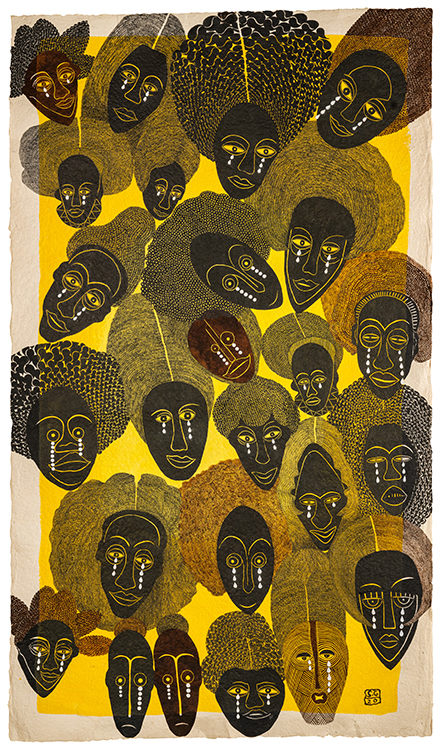- Closed Today
- Ticket
- Shop
- Membership
- TR EN

Selma Gürbüz, 1960-2021
Take Care of Each Other, 2020
Developing a unique style with her application of ink on handmade paper, Selma Gürbüz merged the visual traditions of Western art with Eastern motifs and symbols, reinterpreting and re-producing these in different ways, especially in her paper works. In her production, the artist drew inspiration from Anatolian stories, Eastern and Western mythologies, Shamanistic narratives, Turkish and Persian miniatures, Japanese woodblock prints and Byzantine iconography.
Starting in the twentieth century, African masks made their way into Western art history through art movements such as Cubism, Fauvism and Expressionism as a result of the cultural interactions developing between the Western countries and the African continent reinforced by colonialism. Often used in the ceremonies and religious rituals of communities living on the African continent, these masks are believed to have spiritual powers and are used as a means of communication between humans and nature and the souls of ancestors. Selma Gürbüz used these masks to depict the faces of the Maasai women she encountered during a trip to Tanzania.
In the painting “Take Care of Each Other,” the artist depicts masks of women’s faces with delicate and detailed workmanship, using her technique of inlaying on handmade paper. Painted in black and earth tones on a warm yellow background, these faces shed pearls, yet their expressions are not sad but mischievous and affectionate. The painting emphasizes the resistance of women from different geographies against social and individual challenges with their solidarity and zest for life.
Work on Paper
Inlaying on handmade paper
198 x 115 cm
Istanbul Museum of Modern Art Collection
Acquired by the Women Artists Fund.
2020 Members of the Women Artists Fund
Zeynep Akçakayalıoğlu, Berrak Barut, Revna Demirören, Suzan Sabancı Dinçer, Oya Eczacıbaşı, Selin Gülçelik, Beril Miskavi, Meltem Demirören Oktay, Nesrin Sarıoğlu, Türkan Özilhan Tacir